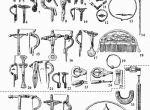Dębczyno Group
Dębczyno Group, archaeological unit developing in Western Pomerania and Vorpommern from late 2nd century to the onset of the 6th century (phases C1a/C1b – E). Its name was introduced by R. Wołągiewicz (1981). The territory of Dębczyno Group settlement stretches between the Uecker and the Łeba rivers and does not go beyond the boundary of the Pomeranian Lakeland in the south.
Two phases of development of Dębczyno Group have been identified: I (C1 – C2) and II (C3/D – E), each with two sub-phases. During sub-phase IIa (which corresponds with phase D of the →Migration Period ) metal dress accessories (fig. 1.) are represented mostly by assorted variants of brooches, type “Bügelknopffibel”, type AVI, 2, with an expanded spade foot (AVI,2, H of Machajewski, subsequently, Mach.), equal-armed →Equal-armed brooch (AVI, 2, I of Mach.), type Wiesbaden (AVI,2, K), similar to sheet brooches of Danubian type (AVI,2, J of Mach.), sporadically, type Nydam, and →Tongue-shaped strap-end, type III of Madyda, buckles with U-shaped frame, or with the thickened distal section of the frame, also, by dress pins, group VIII of Beckmann. More notable bead forms are glass rosette forms and mosaic beads, type 370 of Tempelmann-Mączyńska. In pottery the prevalent form are squat vase-like vessels with a rounded shoulder decorated with stamp impressions, a cordon or a groove combined with a zigzag, jars with a narrow opening and “bucket-like” vessels. They bring to mind Elbian pottery made in Kuhbier/Kyritz style. During sub-phase IIa there is an influx of imported glass vessels with polished ovals (Eggers 220, 226 – 230), tall beakers, type Snartemo, and thick-walled cups, type Dębczyno. Inhumation cemeteries continue at Dzierżęcin, site 1, Borkowice, site 1 and Kowalki, site 1 and there are a few isolated finds of graves in the same rite (e.g., Gąskowo; Gwiazdowo; Stramnica). From the Lower Odra basin we have a record on isolated cremation graves deposited in urns, without the pyre debris, with vase-like vessels with a cylindrical neck similar to forms known from the Lower Elbe and the Weser (Kłęby; Pyrzyce; Resko; →Trzebiatów). During late sub-phase IIa there are finds of hoards of brooches decorated in Sösdala →Sösdala-Untersiebenbrunn Style and Sjörup style (e.g., →Świelino; →Trzebiatów) similar to deposits known from the western Baltic Sea region, and also, coin hoards ending in solidi →Solidus of Valentinian III (425–455). Sub-phase IIa is linked to the settlement horizon III at →Dębczyno , site 6, the settlement horizon at Dębczyno, site 3, and with the archaeology at →Lubieszewo, site 2/a.
The final stage of Dębczyno Culture is designated by sub-phase IIb (phase E of Wołągiewicz). The number of finds attributable to this sub-phase is small, with the more notable forms being equal-armed →Equal-armed brooch and cruciform brooches. Possibly the settlements at Dębczyno, sites 3 and 6, and at →Suchań are still in use during this period. There is evidence on a major stream of gold coins with the latest solidi →Solidus of Anastasius I (491 – 518) and barbarian imitations from the south, especially from the Danubian region. Also noted are hoards, type Karlino →Karlino , comprising gold coins, →Scandinavian Bracteat and metal dress accessories, some of Scandinavian, Byzantine and Italian provenance, and ritual deposits, type Piotrowice, with gold neckrings, reminiscent of the Scandinavian tradition. There is evidence during the same period on a small concentration of a Scandinavian population on the eastern fringe of Dębczyno Culture documented by inhumation burials covered by stone constructions and furnished with brooches with an extended, notched head and foot, including Bornholm variants (variant 2 of Bitner–Wróblewska), dress pins with a stylised bird head and weapons.
The heterogeneous culture outlook of the Dębczyno Group may be seen to evolve over time, the result, presumably, of the involvement of its people in long-distance contacts of their neighbour cultures. This would explain the significant proportion of traditional Elbian elements observed here starting from sub-phase Ia until sub-phase IIa, provenanced to Scandinavia (sub-phase Ia – IIb), Vistula region (phase I) and the Black Sea (phase II). The territory may have even been settled by small groups filtering in from Scandinavia (Bornholm, Scania, Oland or Jutland) and the Elbe region (Holstein or Prignitz).
Deposits type Karlino →Karlino and Piotrowice and the latest solidi finds →Solidus (Anastasius I; 491 – 518) would be, in Western Pomerania and other regions between the Odra and the Vistula, the latest archaeologically recorded group of elements associated with Antique tradition.
HM
Literature: K. Godłowski, The Chronology of the Late Roman and Early Migration Periods in Central Europe, Zeszyty Naukowe Uniwersytetu Jagiellońskiego, Prace Archeologiczne 11, Kraków 1970, p. 56-59; R. Wołągiewicz, Grupa dębczyńska, (in: ) Prahistoria ziem polskich, vol. V, Wrocław-Warszawa- Kraków- Gdańsk, 1981, p. 210-216; K. Godłowski, Okres wędrówek ludów na Pomorzu, Pomorania Antiqua, vol. X (1981), p. 65-129; K. Godłowski, Dębczyno – Gruppe, (in: ) Reallexikon der Germanischen Altertumskunde, vol. 5, Leiferung 3-4, Berlin-New York 1983, p. 266-271; H. Machajewski, Untersuchungen zur Genese der Dębczyno – Gruppe, Zeitschrift fur Archäologie, 22, (1988), p. 65-82; H. Machajewski, Z badań nad chronologią dębczyńskiej grupy kulturowej w dorzeczu Parsęty, Poznań 1992; H. Machajewski, Skandynawskie elementy kulturowe na Pomorzu Zachodnim z okresu wędrówek ludów (2 połowa IV w. – początek VI w.), Przegląd Archeologiczny, vol. 40, (1992), p. 71-96; H. Machajewski, Südzone des Ostseebeckens und der Elbekulturkreis in der späten römischen Kaiserzeit und der frühen Stufe der Völkerwanderungszeit, M. Mączyńska, Zmierzch kultury wielbarskiej – czego nie wiemy?, M. Fudziński, H. Paner (ed.), Nowe materiały i interpretacje. Stan dyskusji na temat kultury wielbarskiej, Gdańsk 2007, p. 365-401; B. Niezabitowska – Wiśniewska et all. ( eds.), The Turbulent Epoch. New materials from the Late Roman Period and the Migration Period, vol. II, Lublin 2008, p. 131-159.
-
 full resolution
full resolution
Fig. 1. Typical artefacts for Dębczyno Group.


